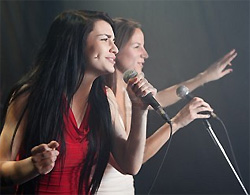Let me start off by saying that Tim Corder has done a great job of writing about monitor mixing. He has several posts tailored for various musicians and even went so far as to include audio examples.
If you haven’t already read them, you should. Tim wrote about building IEM mixes for Electric, Bass, Drums, Keys, and Lead Vocal. Check it out when you have a few minutes.
With that said, I was thinking about helping vocalists set up a useful monitor mix, particularly on a wedge. Though we hope to be putting the band on IEMs soon, the vocalists will stay on wedges for some time.
I was talking with our worship leader about helping the vocalists—all of whom are volunteers—set up better mixes. In my experience, setting up a good monitor sound for a volunteer vocalist is one of the hardest jobs in church audio (perhaps all of audio for that matter), mainly because they often don’t really know what they need.
Most vocalists tend to think they need the entire band in their wedges, all mixed to sound like a CD. While a professional singer (who recorded the CD in the first place) might be able to get away with that, I’m not convinced that technique serves the volunteer vocalist. So here’s what I recommend.
I’ve been using this technique for a good many years, and it was confirmed a few years ago by non other than Robert Scovill during a session I attended (with Tim, incidentally) at the Willow Arts Conference.
I’ve found that putting too much stuff in the mix for a vocalist only causes confusion. The more we put in their wedge, the harder it is for them to sing on pitch—because it’s a lot more for the brain to process. So I suggest, and Robert concurs (hmmm, probably should be the other way around) that vocalists need three, maybe four things in their wedge:
—Tempo reference
—Pitch reference
—Their voice and (optionally)
—Harmony reference
Tempo Reference
This could be snare, kick, hi-hat or perhaps overheads. It doesn’t need to be (and arguably should not be) a complete drum mix. Which part of the drums they need for time will depend on how the drummer plays and what songs they are doing.
In the end, all they need to know is the tempo. Personally, I like hi-hat for this because it’s up and out of the vocal range and thus easy to pick out. It’s also subtle enough that it doesn’t overpower the mix. Your mileage may vary.
Pitch Reference
Again, depending on the band and orchestration, this could be piano, keys or perhaps a guitar. Also again, it should not be all three. Whatever the source, it should provide pitch and key reference. And that’s about it.
Their Voice
One might think this is the most important element—and it is. Singers need to hear themselves. In fact, what is most typically asked for in a monitor mix? More me. The challenge of course, is that if the whole band is in their wedge, we have to put a whole lot “more me” in there so they can hear themselves.
Then they sound unnaturally loud (at least to their ears), so they ask for more of everything else. Which leads to another round of “more me.” Stripping the mix down to Tempo, Pitch and themselves makes it easier to keep levels under control and gives the vocalist what they need.
Harmony Reference (optional)
If you have a group of singers who are singing harmony together, it is sometimes helpful for them to hear the other parts of the harmony. Use this sparingly, however, as it’s really easy to get into an out of control level situation again.
Vocalists need to spend some time learning to hear their voice. It’s a matter of training on their part. By the same token, we can help by not giving them more than they need (which ultimately confuses them).
Now we know what they really need; how do we convince them that this is actually good for them?





















